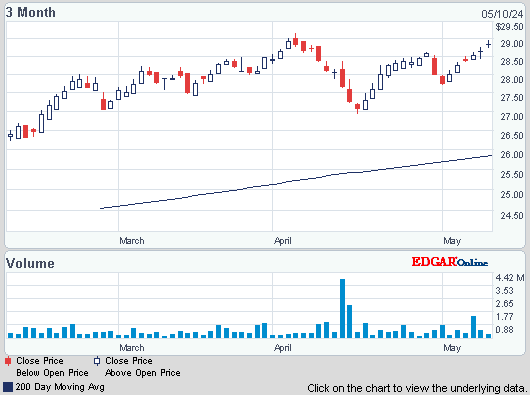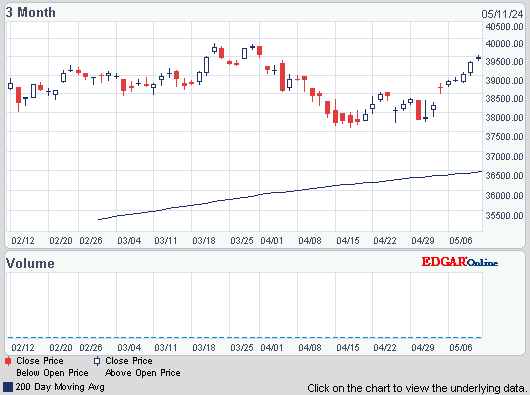Dow rose another 73 to yet another record, advancers over decliners 5-2 & NAZ climbed 29. The MLP index was up fractionally to the 441s & the REIT index also climbed a fraction, to the 264s. Junk bond funds were mixed & Treasuries rose a little. Oil
slipped from the highest level in 2 months while gold waffled at 3 year lows, below 1200..
AMJ (Alerian MLP Index tracking fund)

The EU lost its top credit rating from S&P, which cited the deteriorating creditworthiness of the bloc’s 28 member nations. S&P cut its long-term rating on the EU to AA+, with a stable outlook, from AAA & maintained its short-term rating at A-1+. The downgrade came after S&P last month lowered its AAA rating on the Netherlands. The downgrade “changes nothing,” Pres Hollande of France, Europe’s 2nd-largest economy, said. Global bond yields showed investors ignored 50% of S&P’s rating & outlook changes last year, & 56% of those from Moody’s, more often disagreeing when the ratings companies said govs were becoming safer or more risky. On the EU, S&P said that “downward pressure could build” if the creditworthiness of highly rated EU countries “was to deteriorate beyond our current expectations,” if future budget negotiations are “more protracted & acrimonious,” if member states apply to leave the EU, “or if its financial parameters markedly deteriorate.” Ratings remain under pressure more than 4 years after the outbreak of the debt crisis, which led the EU to offer emergency financing to Greece, Ireland, Portugal, Spain & Cyprus. The EU budget is financed by contributions from the 28 countries & not EU-wide bond sales, & its credit rating is based on the perceived sovereignty of its members. There is little risk that the EU will not be able to access capital markets, S&P said.
European Union Stripped of AAA Credit Rating at S&P
In Q3 the US economy expanded at a faster rate than previously estimated as consumers stepped up spending on services such as health care & companies invested more in software. GDP climbed at a 4.1% annualized rate, the strongest since the Q4-2011 & up from a previous estimate of 3.6%, according to the Commerce Dept. The forecast projected a 3.6% pace after 2.5% in Q2. Inventories accounted for a 3rd of the gain in GDP, showing companies were confident about the prospects for demand. Stronger retail sales in Oct & Nov underscore the Federal Reserve’s view that the economy is improving. Consumer purchases, which accounts for almost 70% of the economy, increased 2%, more than the previously reported 1.4%. Spending on services contributed 0.32 percentage point to Q3 growth, up from a previously reported 0.02 percentage point. In addition to the pickup in outlays for health care, Americans spent more on recreational services. Outlays for non-durable goods climbed at a 2.9%, led by more spending on gasoline. Inventories increased at a $115.7B annual rate, the most in 3 years, after a previously reported $116.5. In Q2, they rose at a $56.6B pace. Stockpiles added 1.67 percentage points to GDP, little changed from the 1.68 percentage-point contribution in the previous reading. GDP will nonetheless be restrained as the pace of inventory growth cools in Q4.
Third-Quarter Growth in U.S. Revised Higher on Services
Stocks are concluding the week on an up note. The GDP data sounds good, but inventory buildup is non recurruing. As the end of the year approaches, portfolio managers are shifting holdings to make themselves look good, giving them an incentive to buy stocks. Janet Yellen will have to wait until congress returns in Jan to officially get her new job running the FED.
Dow Jones Industrials

AMJ (Alerian MLP Index tracking fund)
Treasury yields:
U.S. 3-month |
0.06% | |
U.S. 2-year |
0.38% | |
U.S. 10-year |
2.91% |
| CLG14.NYM | ...Crude Oil Feb 14 | ...98.94 | (0.1%) |
| GCZ13.CMX | ...Gold Dec 13 | .....1,196.60 | (0.1%) |
The EU lost its top credit rating from S&P, which cited the deteriorating creditworthiness of the bloc’s 28 member nations. S&P cut its long-term rating on the EU to AA+, with a stable outlook, from AAA & maintained its short-term rating at A-1+. The downgrade came after S&P last month lowered its AAA rating on the Netherlands. The downgrade “changes nothing,” Pres Hollande of France, Europe’s 2nd-largest economy, said. Global bond yields showed investors ignored 50% of S&P’s rating & outlook changes last year, & 56% of those from Moody’s, more often disagreeing when the ratings companies said govs were becoming safer or more risky. On the EU, S&P said that “downward pressure could build” if the creditworthiness of highly rated EU countries “was to deteriorate beyond our current expectations,” if future budget negotiations are “more protracted & acrimonious,” if member states apply to leave the EU, “or if its financial parameters markedly deteriorate.” Ratings remain under pressure more than 4 years after the outbreak of the debt crisis, which led the EU to offer emergency financing to Greece, Ireland, Portugal, Spain & Cyprus. The EU budget is financed by contributions from the 28 countries & not EU-wide bond sales, & its credit rating is based on the perceived sovereignty of its members. There is little risk that the EU will not be able to access capital markets, S&P said.
European Union Stripped of AAA Credit Rating at S&P
In Q3 the US economy expanded at a faster rate than previously estimated as consumers stepped up spending on services such as health care & companies invested more in software. GDP climbed at a 4.1% annualized rate, the strongest since the Q4-2011 & up from a previous estimate of 3.6%, according to the Commerce Dept. The forecast projected a 3.6% pace after 2.5% in Q2. Inventories accounted for a 3rd of the gain in GDP, showing companies were confident about the prospects for demand. Stronger retail sales in Oct & Nov underscore the Federal Reserve’s view that the economy is improving. Consumer purchases, which accounts for almost 70% of the economy, increased 2%, more than the previously reported 1.4%. Spending on services contributed 0.32 percentage point to Q3 growth, up from a previously reported 0.02 percentage point. In addition to the pickup in outlays for health care, Americans spent more on recreational services. Outlays for non-durable goods climbed at a 2.9%, led by more spending on gasoline. Inventories increased at a $115.7B annual rate, the most in 3 years, after a previously reported $116.5. In Q2, they rose at a $56.6B pace. Stockpiles added 1.67 percentage points to GDP, little changed from the 1.68 percentage-point contribution in the previous reading. GDP will nonetheless be restrained as the pace of inventory growth cools in Q4.
Third-Quarter Growth in U.S. Revised Higher on Services
Home resales in the US fell sharply in
Nov to their lowest level in nearly a year, hurt by a rise in
interest rates since the spring & ongoing price increases that have
shut some home buyers out of the market. The National Association
of Realtors (NAR) said that sales of previously owned homes
dropped 4.3% last month, the 3rd monthly fall in a row, to an
annual rate of 4.9M units. That
was the lowest annual rate since Dec 2012, & well below forecast of a 5.03M unit pace. "It is a clear loss in momentum for home sales," NAR economist Lawrence Yun said. Mortgage
interest rates have risen sharply since May on expectations the Federal
Reserve (FED) would start winding down a bond-buying economic stimulus
program. Yun said the rise in mortgage rates, coupled with fast-rising prices, had made home buying less affordable for many Americans. The median price nationwide rose 9.4% from 2012 to $196K, the first time in a year that prices
didn't rise at a double-digit pace. Yun
said the NAR was "very concerned" about plans by the Federal Housing
Finance Agency to reduce the maximum size of mortgages which can be
bought by taxpayer-owned finance giants Fannie Mae & Freddie Mac. He
said this could further impede the housing market's recovery.
U.S. existing home sales fall to lowest level in nearly a year
Stocks are concluding the week on an up note. The GDP data sounds good, but inventory buildup is non recurruing. As the end of the year approaches, portfolio managers are shifting holdings to make themselves look good, giving them an incentive to buy stocks. Janet Yellen will have to wait until congress returns in Jan to officially get her new job running the FED.
Dow Jones Industrials









No comments:
Post a Comment